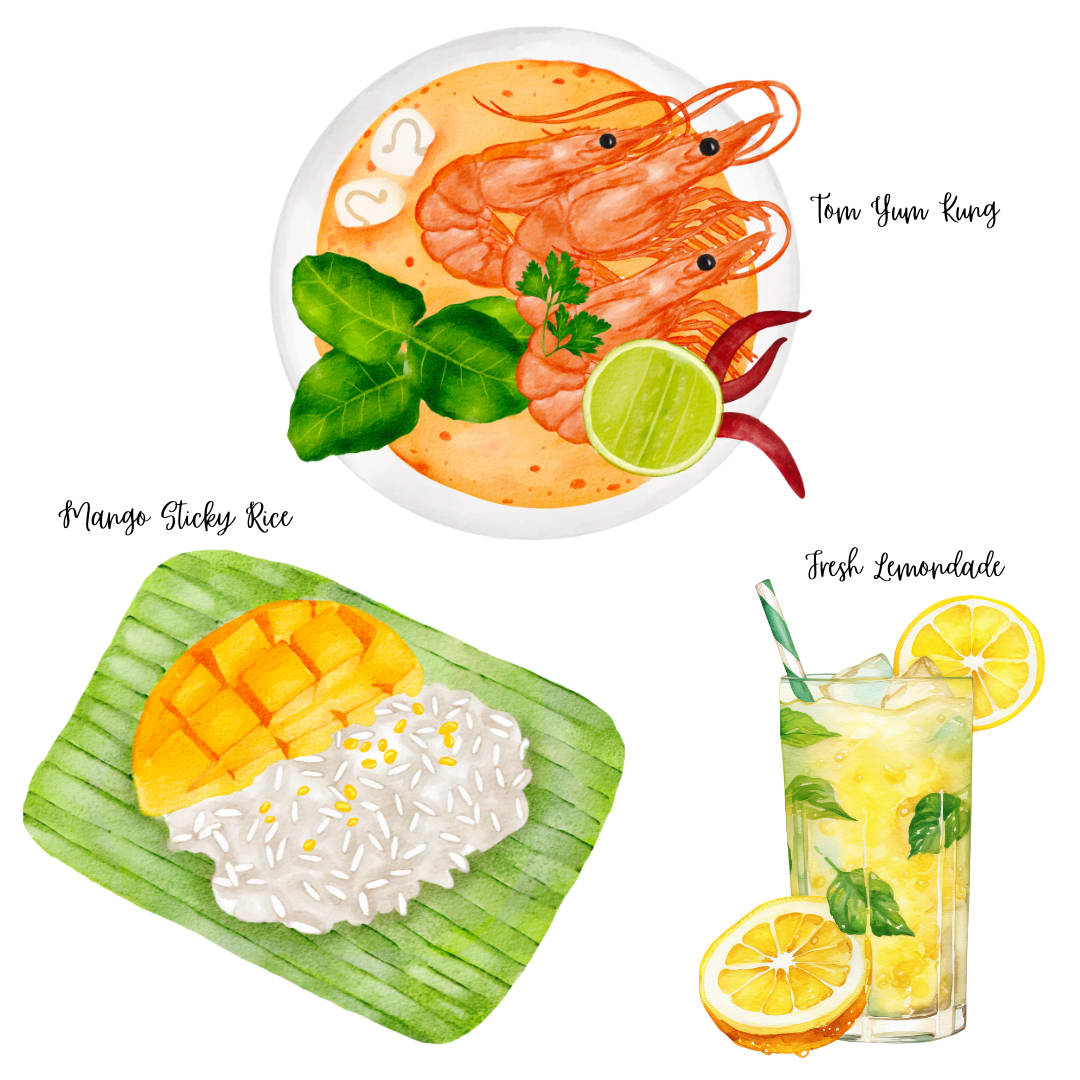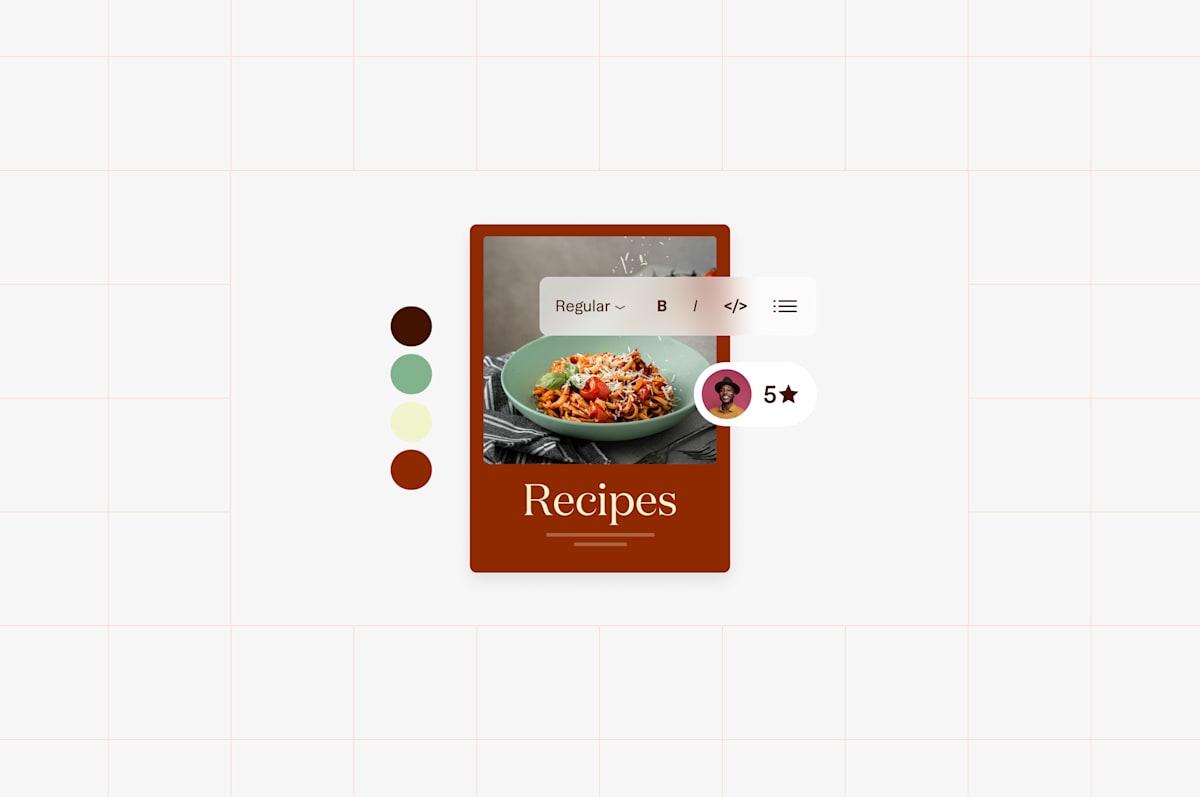How to Make Your Own Recipe Book: A Step by Step Guide
Discover the process of creating a personalized recipe book, from concept to publication. Preserve family traditions, express creativity, and earn income.
 August 13, 2024
August 13, 2024 9 minute reading
9 minute reading
Creating a recipe book is a natural next step for those who love cooking and sharing recipes with friends and family. With 81% of Americans cooking more than half their meals at home, it's the perfect time to compile your culinary wisdom.
But making one goes beyond jotting down ingredients and instructions. It's a way to preserve family favorites, share your passion, and potentially start a new career.
Whether gifting it to foodie friends, satisfying a creative urge, or venturing into the cookbook market, a personalized recipe book offers something mass-market publications can't.
In this guide, you'll learn how to create your own cookbook from start to finish, covering planning, recipe selection, writing, design, and publishing options.
💡 Quick read
Create a recipe book in 8 steps: plan, choose recipes, write content, format, photograph dishes, design layout, publish, and market.
Choose between self-publishing and traditional publishing based on your goals.
With Fiverr’s marketplace, you can hire professionals for writing, editing, photography, or design if needed.
What to know before creating a recipe book
Before starting your cookbook project, get organized and decide what type of cookbook you want to create. Here are some considerations.
Visuals
Unlike other types of books, cookbooks often include visual elements. Consider your options:
Full-color photos: These can be costly unless you do them yourself.
Illustrations: A stylish alternative to photos.
Text-only: Some famous cookbooks, like James Reads ‘Of Cabbages and Kimchi, use no visuals at all.
Decide what role, if any, visuals will play in your book. Your choice will impact both the aesthetics and the budget of your project.
Target readers
Are you creating a family keepsake or selling your cookbook nationwide? Your target audience will greatly influence how you write and publish your cookbook. Consider:
Cooking skills of your audience
Dietary preferences (e.g., vegan, gluten-free)
Specific groups (e.g., college students, pressure cooker enthusiasts)
Where they shop for ingredients
Understanding your audience will help tailor your recipes and presentation to their needs. Look for areas where you can DIY or enlist help from friends and family to keep costs down.
Budget and resources
After defining your cookbook's vision, it's time to budget your time and resources:
List all potential costs (recipe testing, photography, design, printing)
Identify areas where you can DIY or enlist help from friends and family
Consider hiring professionals for specific tasks (Fiverr is a good place to start)
Getting this down now will save you from nasty surprises later on.
Recipe testing
As Julia Child famously said, "A cookbook is only as good as its poorest recipe." Thorough recipe testing is crucial for creating a reliable cookbook. This process helps ensure:
Clear instructions
Accurate ingredients and measurements
Consistent results
Enlist friends, family, or professional recipe testers to prepare your recipes and provide feedback. Use this input to refine your recipes.
Legal and IP protection
When creating a cookbook, it's important to be aware of copyright issues, especially when adapting recipes from other sources. While ingredient lists can't be copyrighted, unique instructions and accompanying text are automatically protected by copyright law. This protection extends to your original content as well.
If you're adapting a recipe, always credit your sources. However, if you're substantially changing a recipe, rewrite the instructions in your own words. This respects copyright law and adds your personal touch to the recipe. For recipes taken directly from another source, seek permission from the copyright holder before including them in your book.
Remember that your original recipes and writing are protected by copyright as soon as you create them. Consider officially registering your copyright for the entire cookbook for added protection and peace of mind.
Benefits of creating a recipe book
Making a recipe book offers many advantages beyond simply compiling your favorite recipes. Let's explore some key benefits that make this endeavor genuinely worthwhile.
Preserve family traditions
A recipe book is a great way to preserve family traditions. By capturing family recipes, you make sure the culinary heritage you've passed down through generations doesn't get lost.

Family cookbooks become a tangible link to your past, an heirloom that allows future generations to connect with their roots, especially at special occasions and during holidays.
Express creativity
A recipe book is also a canvas for your creativity. Whether you're a professional chef or a home cook, it provides an outlet to express your passion for cooking. You can:
Experiment with different formats and themes
Showcase your unique culinary style
Design a book that's both functional and beautiful
Imagine the satisfaction of flipping through a well-designed book that guides you through cooking and reflects your culinary journey.
Earn potential income
Creating a recipe book can also open up potential income streams. In today's digital age, self-publishing platforms and social media have made it easier than ever to reach a global audience.
You no longer need to be a celebrity chef or an established figure to succeed. Consider the inspiring case of B. Dylan Hollis:
In 2020, he was an unknown, unemployed musician with little cooking experience
He started baking and posting vintage-themed baked goods on TikTok
By 2023, he had amassed millions of followers
His recipe book "Baking Yesteryear" became a No.1 number one bestseller, selling 150,000 copies on its first day
His success story shows a well-crafted recipe book's potential reach and impact in the modern era.
Makes for a great gift
Lastly, a personalized recipe book makes for a thoughtful and unique gift. It's perfect for:
Weddings
Birthdays
Holidays
Housewarming parties
Friends and family will appreciate the effort and personal touch, making it a gift that keeps giving. Each time they cook from your book, they'll be reminded of your shared love for food and the memories associated with it.
How to create a recipe book
Now that we've explored the benefits and key considerations of creating a recipe book, it's time to roll up our sleeves and dive into the process. Whether you're a seasoned chef or a passionate home cook, these steps will guide you in bringing your culinary vision to life.
1. Decide on the type of recipe book
The first step in creating your recipe book is deciding on its focus. This decision will shape every aspect of your project, from recipe selection to design and marketing.

Your cookbook should reflect your passion and expertise while appealing to your target audience. Consider the following popular types of cookbooks:
Family recipe collections: A heartwarming compilation of cherished family recipes, often accompanied by personal anecdotes and family history.
Themed cookbooks: Focus on a specific concept, era, or cuisine. For example, you might create a book on '1970s Desserts' or 'Global Street Food Recipes.'
Lifestyle-oriented cookbooks: Cater to specific lifestyles or needs, such as 'Quick Meals for Busy Professionals' or 'Budget-Friendly Cooking for Students.'
Diet-specific cookbooks: Target particular dietary needs or preferences, like 'Gluten-Free Baking' or 'Keto-Friendly Comfort Foods.'
Seasonal cookbooks: Focus on holiday cooking, summer grilling, or autumn harvest recipes.
When choosing your cookbook's focus, consider your own culinary strengths and interests. What unique perspective can you bring to the table? Perhaps you have a knack for simplifying complex dishes or a passion for fusion cuisine.
Also, think about your target audience. Who are you writing for? What are their needs, preferences, and skill levels in the kitchen? A cookbook for experienced chefs will look very different from one for novice cooks.
Remember, your chosen focus should be specific enough to stand out in a crowded marketplace, but broad enough to include a variety of recipes. For instance, instead of just "Italian Cooking," you might focus on "Authentic Tuscan Family Recipes" or "Modern Twists on Classic Italian Dishes."
2. Choose how you’ll publish the book
Once you've decided on the type of cookbook you want to create, the next crucial step is determining how you'll bring it to your audience. The publishing landscape offers two main paths: self-publishing and traditional publishing.
Each has its unique advantages and challenges. Self-publishing offers more control and higher royalties but requires more personal investment in marketing and distribution. Traditional publishing provides professional support and wider reach but means surrendering some control and a larger share of profits.
Let's explore both options to help you make an informed decision.
Self-publishing
This route has gained immense popularity in recent years, especially for digital cookbooks. It's ideal for sharing personal recipe collections and niche concepts or when you want to maintain complete control over your project. It's also great for testing the market before approaching traditional publishers.
Some popular formats include:
Ebooks: Digital books that are to distribute through platforms like Amazon Kindle Direct Publishing.
Print-on-demand: Services like IngramSpark or Lulu allow you to print books as they're ordered.
Short-run printing: Ideal for limited editions or when you want physical copies on hand.
🧠 Learn: How to Self-Publish a Book: 7 Easy Steps
Traditional publishing
This path involves working with an established publishing house. It can be more challenging to break into, but it offers access to editors, designers, and marketing teams. Plus, the backing of a known publisher can lend authority to your work.
The traditional publishing process typically involves:
Securing a literary agent (often required for larger publishing houses)
Preparing a comprehensive book proposal
Pitching to publishers
Negotiating a contract if a publisher shows interest
Traditional publishing take longer, sometimes taking 18-24 months from contract to bookshelf. However, it can be worthwhile if you believe your cookbook has broad appeal and you want to leverage the resources of an established publisher.
These paths aren't mutually exclusive. Many authors start with self-publishing to build a following and later transition to traditional publishing, or vice versa. The key is to choose the path that best aligns with your vision for your cookbook and your long-term goals as an author.
🧠 Learn: How To Sell Books on Amazon: A Beginner's Guide
3. Set goals and timelines
Creating a cookbook is an exciting journey, but it can quickly become overwhelming without clear goals and a structured timeline. This step is crucial in turning your culinary dreams into a tangible reality.
Start by defining your goal. Ask yourself:
Is this a personal project to preserve family recipes?
Are you aiming to establish yourself as a culinary authority?
Do you want to create a bestselling cookbook?
Is this a stepping stone to a larger culinary career?
Then, determine the number of recipes in your book. There are no strict rules, but generally, a full-length custom cookbook has 75-150 recipes. A smaller, specialized cookbook might have 30-50 recipes.
With your recipe count in mind, set a realistic timeline. Be generous with your estimates – DIY cookbook creation often takes longer than expected. As a general guideline, give yourself 9-18 months from start to finish for an entire cookbook project, depending on its complexity and your available time and resources.
4. Choose your recipes
The heart of your cookbook project is selecting the right recipes. Start by gathering all potential recipes that fit your book's theme. These might come from your personal collection, family archives, or newly developed ideas.
Aim for a mix of difficulty levels and preparation times to keep your cookbook accessible and exciting. For a well-rounded cookbook, ensure you have a good balance of dishes across different categories (appetizers, main courses, desserts, etc.).
5. Write and format your recipes
As you write, imagine yourself in your reader's kitchen, guiding them through each step of the culinary journey.
Focus on these elements:
Clear, concise instructions. Make cookbook recipes easy to follow. Write clear step-by-step instructions that anyone can follow.
Standardize measurements. Use consistent measurements and ingredients throughout your cookbook.
Include prep and cooking times: State each recipe's preparation and cooking times so readers can plan the meal effectively.
Add personal notes or short stories. Personalize your recipes with anecdotes to connect with readers and add character to your cookbook.
Your goal is to make each recipe accessible to both novice and experienced cooks. Be thorough in your descriptions, but avoid unnecessary complexity. Consider asking a friend or family member to test your recipes to ensure clarity and accuracy.
If writing isn’t your thing, you can also hire a ghostwriter to cook up the words while you prepare the meals. They can work on your book blurb, author bio, and recipes. Ghostwriting costs anywhere between $49 to $84 per hour, on average.
💡Pro tip: Hire a professional editor to proofread your book and catch any errors. They can also help structure recipes so readers can understand and act on them.
6. Photograph your dishes
Visual appeal is crucial in a cookbook. After all, we eat with our eyes first. Whether your audience is family or a wider paying readership, compelling images can transform your recipe book from a mere collection of instructions into an inspiring culinary journey.

If you're taking photos yourself:
Use a decent camera or smartphone. Today's technology can yield impressive results.
Ensure your dishes are well-presented. Think about plating and garnishes.
Experiment with natural light. It often produces the most appealing food photography.
Compose your shots thoughtfully. Focus on the dish and avoid cluttered backgrounds.
Consider using photo editing software to enhance your images by adjusting brightness, contrast, and colors to make your dishes look irresistible. The goal is to make your readers' mouths water and inspire them to head straight to the kitchen.
If photography isn't your forte, consider using illustrations, a professional food photographer, or AI tools like Midjourney to create stunning visual representations of your dishes.

Illustration examples created in Canva by the author
Whether you choose photography or illustrations, consistent style throughout your book will create a polished, professional look.
7. Design your recipe book
Start by choosing a layout and theme that resonates with your culinary style. Whether you're going for rustic charm or sleek modernity, ensure your design is visually appealing and easy to follow. If design isn't your forte, hire a professional cookbook designer to bring your vision to life.
When it comes to tools, you have options. While professional software like Adobe InDesign offers advanced features, user-friendly platforms like Canva can be excellent for beginners. Choose based on your skill level and budget.
As you design, pay attention to these key elements:
Typography: Select fonts that are easy to read and match your theme
Color palette: Choose colors that enhance your food photography and overall aesthetic
Page layouts: Create consistent layouts for recipe pages, chapter openers, and content pages
Visual hierarchy: Use headings, subheadings, and different font sizes to guide readers through your book
Your cover design deserves special attention. It's the first impression your book will make. Whether designing it yourself or working with a professional, create multiple options and choose one that truly reflects your content and appeals to your target audience.
Above all, maintain consistency in your design elements throughout the book. This creates a professional, cohesive look that will keep your readers engaged, from appetizers to desserts. Good design enhances the reader's experience, making your recipes not just instructions but a journey through your culinary world.
8. Promote and market your recipe book
Creating your cookbook is only half the battle. Now, it's time to get it into the hands of eager cooks. A well-planned marketing strategy can distinguish between a hidden gem and a bestseller.
Spread the word on social media
Start by promoting your book on social media. Platforms like Instagram, TikTok, and Pinterest are perfect for showcasing your mouth watering recipes and behind-the-scenes content. Create a consistent posting schedule and use relevant hashtags to increase visibility. Remember to engage with your followers; their excitement can be contagious!
Form partnerships and community
Collaborate with food bloggers and influencers in your niche. Offer them a free copy of your book for an honest review or feature. Their endorsement can introduce your cookbook to a new audience of potential buyers.
Use online communities and Facebook groups dedicated to cooking and recipe sharing. Participate in discussions, share cooking tips, and subtly promote your book. Remember, it's about building relationships, not just selling.
Run ads
Consider running targeted ads on social media platforms. With careful audience selection and compelling visuals, even a modest ad budget can significantly boost your book's visibility.
Don't underestimate the power of traditional media. Reach out to local newspapers, food magazines, and radio shows. A feature story or interview can generate buzz and credibility for your cookbook.
Marketing is an ongoing process. Stay persistent, be creative, and, most importantly, let your passion for cooking shine through in every interaction. Your enthusiasm will be your best selling point.
Hire the right people to create your recipe book today
Creating a recipe book is a rewarding project allowing you to share your culinary passion.
While it requires effort and attention to detail, the process can be streamlined and enhanced by leveraging the diverse talents available on Fiverr. From professional writers who can help refine your instructions to skilled book editors who ensure your content is polished and error-free, Fiverr offers valuable resources at every stage.
You can focus on what you do best – creating delicious recipes – while leaving the technical aspects to skilled professionals. Whether you're a home cook looking to preserve family recipes or a professional chef aiming to publish your first cookbook, Fiverr's talent marketplace can help turn your recipe book dream into a reality.
How to make a recipe book FAQ
How do you create a recipe book for free?
You can create a recipe book for free using free online tools like Google Docs or Canva. You can also use a basic word processor to design the layout yourself, then save it as a PDF for digital distribution.
Is there an app to make a cookbook?
Yes, several apps are designed specifically for creating cookbooks. Some popular options include Paprika Recipe Manager and BigOven.
Does Word have a recipe book template?
Yes, Microsoft Word does offer recipe book templates. You can find these by opening Word, clicking on "New," and then searching for "recipe book" or "cookbook" in the template search bar.
Can I make a recipe book online?
Absolutely, you can create a DIY recipe book online using various platforms. Websites like Blurb, Shutterfly, and Mixbook offer tools specifically for designing and printing cookbooks, while more general platforms like Canva can also be used for this purpose.
Checklist for making your own recipe book

To sum everything up, we’ve created a helpful checklist so you can make sure you’ve got everything covered when it comes to creating your own recipe book
Get ChecklistDefine Your Vision
Decide on the type of recipe book (e.g., family recipes, themed, diet-specific).
Identify your target audience and their preferences.
Set clear goals (personal project, income generation, creative outlet).
Plan Your Budget and Resources
List potential costs (recipe testing, photography, design, printing).
Identify areas for DIY or enlist help from friends and family.
Consider hiring professionals for specific tasks.
Test and Refine Your Recipes
Ensure clear instructions, accurate ingredients, and consistent results.
Enlist others to test recipes and provide feedback.
Refine recipes based on feedback.
Ensure Legal and IP Protection
Be aware of copyright issues when adapting recipes.
Credit sources and rewrite instructions for adapted recipes.
Consider registering your cookbook's copyright.
Choose Your Publishing Path
Decide between self-publishing or traditional publishing.
Evaluate the pros and cons of each method.
Consider hybrid options (e.g., starting with self-publishing, then transitioning).
Set Realistic Goals and Timelines
Determine the number of recipes and overall content.
Create a timeline for each phase (writing, testing, designing, publishing).
Allow extra time for unexpected delays.
Select and Write Your Recipes
Gather and select recipes that fit your theme.
Write clear, concise instructions with standardized measurements.
Include prep and cooking times, and add personal notes or anecdotes.
Photograph Your Dishes
Use quality photos or illustrations to enhance visual appeal.
Consider hiring a professional photographer or using DIY methods.
Ensure consistency in style and presentation.
Design Your Recipe Book
Choose a layout and theme that matches your content.
Focus on typography, color palette, and page layouts.
Design a compelling cover that reflects your book’s essence.
Publish and Market Your Recipe Book
Decide on the format (print, digital, both).
Develop a marketing strategy using social media, partnerships, and ads.
Promote your book through influencers, food bloggers, and local media.
Hire the Right People
Utilize platforms like Fiverr to hire writers, editors, designers, and more.
Delegate technical tasks to professionals while you focus on content.
Prepare for Publication
Finalize your book, ensuring all elements are polished.
Choose the right platform for publishing (self-publishing sites, traditional publishers).
Plan a launch strategy and continue marketing efforts post-launch.
💡 Bonus Tips:
Use Free Tools: Platforms like Google Docs and Canva for free layout design.
Leverage Apps: Consider cookbook-specific apps like Paprika Recipe Manager.
Explore Templates: Utilize recipe book templates available in Word and online platforms.



